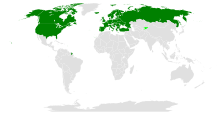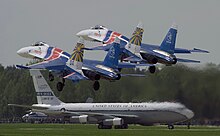Open Skies Treaty
Treaty on Open Skies , OH contract or Open Skies ( English for open sky ) an agreement made in 1992 between NATO - and the former Warsaw Pact -Staaten that there participating nations allowed each other's territories on fixed routes to fly over and take pictures ( photo , radar and, since 2006, infrared ). This confidence-building measure is intended to secure peace and avoid conflicts.
On May 21, 2020, Robert O'Brien , National Security Advisor to US President Donald Trump , announced that the United States would withdraw from the treaty.
history
Conclusion of the agreement
The Open Skies Treaty was signed on March 24, 1992. Signatory states (or their successor states) are Belgium , Denmark , Germany , France , Greece , Great Britain , Iceland , Italy , Luxembourg , the Netherlands , Norway , Spain , Portugal , the USA , Canada , Bulgaria , Georgia , Kyrgyzstan (not yet ratified), Poland , Romania , Russia , Slovakia , the Czech Republic , Ukraine , Hungary , Belarus and Turkey . Are newly joined Sweden , Finland , Latvia , Lithuania , Georgia, Slovenia , Bosnia-Herzegovina . Austria has expressed interest in joining, Switzerland is not participating. Cyprus has applied to join the treaty, but Turkey has blocked it.
The idea of such a treaty had already been proposed in 1955 by the then President of the United States of America Dwight D. Eisenhower to the Soviet leadership during the Geneva Four Power Conference ; however, the follow-up failed due to Soviet fears that the observation flights could be used for espionage purposes.
In 1989, US President George Bush resumed the idea of building confidence through observation flights within the framework of the CSCE . Negotiations between NATO and the Warsaw Pact began in February 1990. Differences of opinion and, in particular, the continuing fear of espionage by the West on the Soviet side led to the negotiations being postponed indefinitely.
Only when the NATO countries introduced the idea of an air inspection regime for verification of the CFE treaty , which contained essential elements of Western OH ideas, in the context of negotiations in Vienna on conventional armed forces in Europe , did the project receive a new impetus. Since a detailed regulation on an air inspection regime could no longer be included due to the negotiation time pressure for the CFE contract, a general note was included that inspections from the air can in principle be carried out within the CFE application area. The NATO countries then made greater efforts to resume the OH negotiations. The interest on the part of NATO was all the greater since Russia had meanwhile started to move weapons and equipment stocks that were to be disarmed under the CFE Treaty from the area of application of the CFE Treaty, which extended to the Urals , behind the Urals. The spatial validity of the Open Skies Treaty was extended to the entire area from Vancouver to Vladivostok . The German open sky mission is observing an area of 17,799,997 km².
Incident between Russia and Turkey
In January 2016, a Russian observation aircraft could not fly over Turkey because Russia and Turkey could not agree on a route in accordance with the regulations.
Potential exit by the United States
With the increasing age of aircraft - in 2017 already about 60 years - the USA saw less and less sense in equipping new aircraft, especially since the data that the USA collected by other means were much more precise anyway. Russia pursued a different strategy, equipping its new aircraft with the latest technology that meets the requirements of the contract (a resolution of not less than 30 cm).
The US State Department accuses Russia of continuously breaking the terms of the treaty since 2005, including by using the overflights for espionage purposes. When Russia no longer wanted to allow flights via Kaliningrad , the USA considered from September 2017, for its part, to no longer allow Russian flights over its territory. This question was raised again after the US allowed the Russians to fly at low altitude over central Washington, over the White House , the Capitol and the Pentagon . The head of the Defense Intelligence Agency and the commander of the Strategic Command warned the US Congress that the exploitation of the treaty by Russia posed a threat to national security. On the other hand, the chairman of the Foreign Affairs Committee of the US Congress warned the new National Security Advisor Robert O'Brien in October 2019 that a withdrawal from the agreement could benefit Russia and harm America's allies despite the problems with Kaliningrad, South Ossetia and Abkhazia . Russian military analyst Pawel Felgenhauer said in 2019 that the Open Skies Treaty symbolizes "primarily trust between former opponents in the Cold War, but today there is no trust".
In May 2020, the US government announced the US would withdraw from the agreement on the grounds that Russia had not complied with requirements. The other NATO countries did not support the decision to terminate Open-Skies. Some NATO partners expressed their regret at the American government's decision. However, NATO agreed to put pressure on Russia to reach an agreement with Russia on issues relating to the implementation of the treaty, such as control flights over the area around Kaliningrad.
philosophy
The original idea after the Second World War was to be able to identify and react to military changes and activities in other countries in good time through mutual observation flights. When the idea was resumed in 1989, the focus was on building trust through openness and transparency, combined with the impetus given by the CFE Treaty to verify the arms control obligations from the air.
In addition, the expansion of air observation to other areas is expressly provided for in the contract. An open skies observation aircraft can also be used to obtain information about the situation in international crisis situations, for conflict prevention, for crisis management and for environmental monitoring . The commission, which meets monthly, is based at the OSCE in Vienna and is responsible for implementation issues of the treaty.
implementation
It has been applied provisionally since the signing of the treaty. Through bilateral test observation missions, important practical experience for the implementation could be gathered. The cooperation takes place in a trusting, friendly atmosphere. Although Germany no longer had its own observation aircraft after the crash of the German Open Skies aircraft that had been converted for use as an observation aircraft in 1997, it took an active part in the preliminary implementation. The entry into force of the treaty was delayed due to the lack of ratifications by the parliaments of Ukraine, Russia and Belarus.
The contract came into force on January 1, 2002. The observation aircraft of the participating countries were certified in 2002 and the first "sharp" flights under the contract took place. The OSCC set up working groups to pass resolutions on important issues relating to the application of the treaty.
After the accident of the Tupolev Tu-154M Open Skies aircraft , Germany did not have its own open skies aircraft for 18 years. In 2015, the German armed forces tendered an Airbus A319CJ , for which 60 million euros were made available by the German parliament. An Airbus A319 was purchased from Volkswagen, which was converted by Lufthansa Technik by June 2019 so that the aircraft is available not only to the Air Force, but also to other contractual partners on a rental basis to carry out open-skies flights.
In 2019, the Netherlands, Canada, Belgium, Luxembourg, France, Greece, Italy, Portugal and Spain shared a converted C-130 Hercules transporter with a SAMSON reconnaissance container. Bulgaria, Romania and Ukraine were still using the An-30 , while Sweden had a Saab 340 certified.
literature
- Rüdiger Hartmann, Wolfgang Heydrich: The contract on the open sky - development and content of the contract, commentary, documentation. Nomos-Verl.-Ges., Baden-Baden 2000, ISBN 3-7890-6513-7 .
- Wolfgang Richter: Attack on the Open Skies contract (= SWP-Aktuell . 2020 / A 38). May 2020, doi : 10.18449 / 2020A38 ( swp-berlin.org [PDF; accessed on May 22, 2020]).
Web links
- Text of the Treaty on Open Skies (PDF; 112 p .; accessed July 30, 2014)
- Open Skies Consultative Commission on the OSCE website
Individual evidence
- ↑ a b USA announce exit from Open Skies contract. In: Handelsblatt . May 21, 2020, accessed May 21, 2020 .
- ↑ 20 years of Open Skies , from osce.org, accessed November 25, 2019
- ↑ http://www.streitkraeftebasis.de/portal/poc/streitkraeftebasis?uri=ci%3Abw.skb_piz.servic.infos.afacts
- ↑ Turkey rejects Russian request for routine observation flight , Reuters, February 4, 2016; The Turkish foreign ministry said observation flights only take place when both sides can agree the mission plan, pointing out that Russia imposed limitations on flights over its territory
- ↑ a b c Павел Фельгенгауэр: Воздуха нет. США готовы к выходу из Договора об открытом небе. In: novayagazeta.ru. November 25, 2019, accessed June 2, 2020 (Russian).
- ↑ 2005 Adherence to and Compliance With Arms Control, Nonproliferation, and Disarmament Agreements and Commitments. Retrieved May 22, 2020 .
- ↑ US to Curb Russian Military Flights Over American Territory , Wall Street Journal, September 26, 2017
- ↑ 2018 Report on Adherence to and Compliance With Arms Control, Nonproliferation, and Disarmament Agreements and Commitments. In: United States Department of State. Retrieved May 22, 2020 (American English).
- ↑ Joe Gould: Pentagon Official Decries Russian Flights Over US. August 8, 2017, Retrieved May 22, 2020 (American English).
- ↑ Eric Schmitt, Michael R. Gordon: Russia Wants Closer Look From Above the US In: The New York Times . February 22, 2016, ISSN 0362-4331 ( nytimes.com [accessed May 22, 2020]).
- ^ Tim Morrison: Opinion | Russia Flouts Another Treaty. So We're Leaving It. In: The New York Times . May 21, 2020, ISSN 0362-4331 ( nytimes.com [accessed May 22, 2020]).
- ^ Letter (PDF) , October 7, 2019, US House of Representatives - Committee of Foreign Affairs
- ↑ NATO partners refuse US support. In: Zeit Online . May 22, 2020, accessed May 27, 2020 .
- ↑ Pivot Area, December 23, 2016: New "Open Skies" aircraft for the Bundeswehr , accessed on January 31, 2017.
- ↑ A319 Open Skies for the Air Force , Flugrevue, June 21, 2019
- ↑ Welt online , January 30, 2017: Winterkorn Airbus is now securing world peace , accessed January 31, 2017



